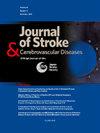The relationship between flavonols intake and stroke in the elderly: a cross-sectional study from NHANES (2007-2010 and 2017-2018)
IF 1.8
4区 医学
Q3 NEUROSCIENCES
Journal of Stroke & Cerebrovascular Diseases
Pub Date : 2025-06-07
DOI:10.1016/j.jstrokecerebrovasdis.2025.108373
引用次数: 0
Abstract
Background
Stroke is a common fatal and disabling disease in the elderly. We investigated the correlation and potential benefits of dietary intake of flavonoid compounds and their subclasses in elderly stroke patients.
Methods
This study analyzed data from the National Health and Nutrition Examination Survey (NHANES) for the cycles 2007-2010 and 2017-2018. Dietary flavonoids intake was calculated based on food frequency questionnaires (FFQ) through a 24-hour dietary recall. To explore the relationship between flavonoids intake and their subclasses with stroke prevalence, we employed multivariable logistic regression models, adjusting for relevant covariates. Restricted cubic splines (RCS) and generalized additive models (GAMs) were applied to explore potential nonlinear relationships between flavonols subclasses and stroke prevalence. Multivariable logistic regression models were conducted both for the overall population and stratified by flavonols subclasses intake. Additionally, we utilized Bayesian kernel machine regression (BKMR) to evaluate the overall effect of flavonols intake levels on stroke status, accounting for potential interaction and correlation between subclasses. Given the high correlation among flavonols subclasses, we incorporated a hierarchical variable selection approach using a Markov Chain Monte Carlo (MCMC) algorithm. Finally, we analyzed the XGBoost model by applying SHAP (SHapley Additive exPlanations) values to assess the specific contribution of different flavonoids intake to stroke.
Results
Including 3,806 elderly stroke patients, the study revealed an inverse relationship between dietary flavonoids and their subclasses and stroke prevalence. After adjusting for potential confounders, it was found that higher quartiles of flavonols intake were associated with lower stroke prevalence. Specifically, with each unit increase in flavonols (Q4) intake, the odds of stroke in the elderly decreased by 61 % (OR=0.390, 95 % CI [0.209-0.728]; P = 0.005). Similar results were observed for the subclasses of flavonols. Subgroup analyses indicated that age and poverty index ratio (PIR) were effect modifiers in the relationship between flavonols intake and stroke. We further examined the intake levels of dietary flavonols subclasses such as isorhamnetin, kaempferol, myricetin, and quercetin and their association with stroke status stratified by population characteristics. In addition to age and PIR, hyperlipidemia and body mass index (BMI) were found to be the most common significant influencing factors in the relationship between flavonols subclasses and stroke prevalence. Furthermore, RCS revealed a “U”-shaped nonlinear relationship between flavonols, including their quercetin and kaempferol subclasses, and stroke, whereas the relationship between stroke and myricetin was linear. Our study also assessed the overall impact of dietary flavonols subclasses on stroke in the elderly and the interrelationships among these subclasses. The results consistently indicated a negative joint effect of flavonols subclass mixtures on the stroke status in the elderly. When evaluating the impact of individual flavonols subclasses on stroke status, a potential dose-response relationship was observed, with increasing intake of myricetin being associated with a decreased risk of stroke. Furthermore, SHAP plots show that flavonols intake is predominantly associated with negative SHAP values, indicating that higher dietary flavonols intake corresponds to a lower predicted stroke risk.
Conclusion
These results emphasize that adhering to an increased dietary intake of flavonoid compounds, particularly flavonols and their subclasses such as myricetin, is inversely associated with the prevalence of stroke among the U.S. elderly population. This offers potential benefits for stroke patients, especially among elderly individuals aged 60-70 and those with higher incomes.
老年人黄酮醇摄入量与脑卒中的关系:NHANES的横断面研究(2007-2010和2017-2018)
中风是老年人常见的致死性致残性疾病。我们研究了老年脑卒中患者饮食中摄入类黄酮及其亚类的相关性和潜在益处。方法本研究分析了2007-2010年和2017-2018年国家健康与营养调查(NHANES)的数据。通过24小时饮食召回,根据食物频率问卷(FFQ)计算膳食黄酮类化合物的摄入量。为了探讨类黄酮摄入量及其亚类与卒中患病率之间的关系,我们采用了多变量logistic回归模型,调整了相关协变量。应用限制三次样条(RCS)和广义加性模型(GAMs)探讨黄酮醇亚类与脑卒中患病率之间潜在的非线性关系。对总体人群和按黄酮醇亚类摄入量分层进行了多变量logistic回归模型。此外,我们利用贝叶斯核机回归(BKMR)来评估黄酮醇摄入水平对中风状态的总体影响,考虑潜在的相互作用和亚类之间的相关性。考虑到黄酮醇亚类之间的高度相关性,我们采用了马尔可夫链蒙特卡罗(MCMC)算法的分层变量选择方法。最后,我们运用SHapley加性解释(SHapley Additive explanatory)值分析了XGBoost模型,以评估不同类黄酮摄入量对中风的具体贡献。结果包括3806例老年中风患者,该研究揭示了膳食类黄酮及其亚类与中风患病率之间的反比关系。在调整了潜在的混杂因素后,发现高四分位数的黄酮醇摄入量与较低的卒中患病率相关。具体来说,黄酮醇(Q4)摄入量每增加一个单位,老年人中风的几率降低61% (OR=0.390, 95% CI [0.209-0.728];P = 0.005)。在黄酮醇亚类中观察到类似的结果。亚组分析表明,年龄和贫困指数比(PIR)是黄酮醇摄入量与脑卒中关系的影响调节因子。我们进一步研究了膳食黄酮醇亚类的摄入水平,如异鼠李素、山奈酚、杨梅素和槲皮素,并根据人群特征对它们与卒中状态的关系进行了分层。除了年龄和PIR外,高脂血症和身体质量指数(BMI)被发现是黄酮醇亚类与卒中患病率关系中最常见的显著影响因素。此外,RCS显示黄酮醇(包括槲皮素和山奈酚亚类)与中风呈“U”型非线性关系,而杨梅素与中风呈线性关系。我们的研究还评估了膳食黄酮醇亚类对老年人中风的总体影响以及这些亚类之间的相互关系。结果一致表明黄酮醇亚类混合物对老年人中风状态有负联合作用。当评估单个黄酮醇亚类对卒中状态的影响时,观察到潜在的剂量-反应关系,杨梅素摄入量增加与卒中风险降低相关。此外,SHAP图显示,黄酮醇摄入量主要与负SHAP值相关,表明较高的膳食黄酮醇摄入量对应于较低的预测卒中风险。结论:这些结果强调,坚持增加饮食中类黄酮化合物的摄入,特别是黄酮醇及其亚类如杨梅素,与美国老年人中风的患病率呈负相关。这为中风患者提供了潜在的好处,尤其是60-70岁的老年人和收入较高的人。
本文章由计算机程序翻译,如有差异,请以英文原文为准。
求助全文
约1分钟内获得全文
求助全文
来源期刊

Journal of Stroke & Cerebrovascular Diseases
Medicine-Surgery
CiteScore
5.00
自引率
4.00%
发文量
583
审稿时长
62 days
期刊介绍:
The Journal of Stroke & Cerebrovascular Diseases publishes original papers on basic and clinical science related to the fields of stroke and cerebrovascular diseases. The Journal also features review articles, controversies, methods and technical notes, selected case reports and other original articles of special nature. Its editorial mission is to focus on prevention and repair of cerebrovascular disease. Clinical papers emphasize medical and surgical aspects of stroke, clinical trials and design, epidemiology, stroke care delivery systems and outcomes, imaging sciences and rehabilitation of stroke. The Journal will be of special interest to specialists involved in caring for patients with cerebrovascular disease, including neurologists, neurosurgeons and cardiologists.
 求助内容:
求助内容: 应助结果提醒方式:
应助结果提醒方式:


